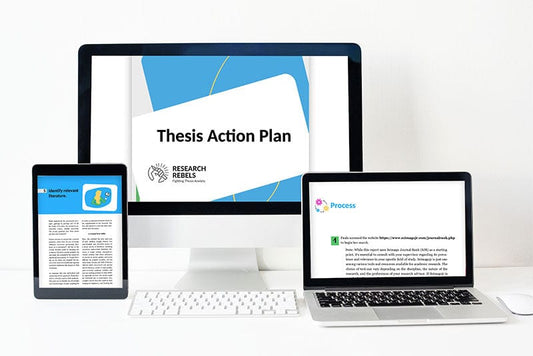How to Write Your Thesis in One Month: From Blank Page to Bound Copy

Writing a thesis in just one month might sound impossible, but with the right plan and mindset, it’s totally doable. Whether you’re feeling stuck or just overwhelmed by the sheer size of the task, this guide is here to help. We’ll break things down into simple, actionable steps so you can go from staring at a blank page to holding your finished, bound copy in record time. Let’s dive in and make this happen.
Key Takeaways
- Stick to a daily schedule with clear, achievable goals to keep yourself on track.
- Create a solid outline before you start writing to organize your ideas.
- Use tools and resources like online courses or coaching to get expert advice.
- Tackle challenges like writer’s block by breaking tasks into smaller steps.
- Ensure your thesis meets all formatting and submission guidelines early on.
Developing a Structured Daily Writing Plan
Setting Realistic Daily Goals
Writing a thesis in one month might sound like a stretch, but breaking it down into daily goals makes it manageable. Consistency is key—set a word count or task for each day, like drafting an introduction or revising a methodology section. Keep your goals small enough to fit your schedule but substantial enough to keep momentum. For example:
| Day | Task | Estimated Time |
|---|---|---|
| 1 | Write thesis outline | 2 hours |
| 2 | Draft introduction | 3 hours |
| 3 | Review literature | 4 hours |
This approach ensures steady progress without burnout.
Using Checklists to Track Progress
A checklist can be your best friend during this process. It’s satisfying to tick off completed tasks and see how far you’ve come. Include milestones like "Complete Chapter 1" or "Submit Draft for Feedback." Here’s an example of a simple checklist:
- [ ] Create a detailed thesis outline
- [ ] Write the introduction
- [ ] Compile key research articles
- [ ] Draft methodology section
- [ ] Revise Chapter 1
This method keeps you organized and motivated.
Balancing Writing with Research
It’s tempting to dive deep into research and postpone writing, but balancing the two is crucial. Dedicate specific blocks of time for each activity. For instance:
- Morning: Write 500 words
- Afternoon: Review 3 research papers
- Evening: Edit morning’s writing
This rhythm ensures you’re progressing on both fronts without neglecting one. Remember, writing and research feed into each other, so don’t wait to "finish researching" to start writing.
Mastering the Art of Thesis Organization
Creating a Clear Outline
Starting your thesis without an outline is like setting off on a road trip without a map. A good outline lays out the structure of your thesis and keeps you from veering off track. Begin by listing the major sections—introduction, literature review, methodology, results, discussion, and conclusion. Then, break each section into smaller subsections. For example, your literature review might include categories like "Key Theories" and "Recent Studies." A clear and detailed outline will save you hours of frustration later.
Structuring Chapters Effectively
Each chapter in your thesis serves a specific purpose, so make sure the structure reflects that. Start every chapter with a brief introduction that explains its focus. Use headings and subheadings to divide content into digestible parts. For example, in your methodology chapter, you might have sections for "Research Design," "Data Collection," and "Analysis Methods." Don’t forget to end each chapter with a summary that ties the content back to your research goals. This keeps your thesis cohesive and easy to follow.
Integrating Research Seamlessly
Your research is the backbone of your thesis, but it needs to be woven into your writing naturally. Avoid dumping raw data into your chapters without context. Instead, introduce your findings, explain their significance, and connect them back to your research question. Use tables or bullet points to present data clearly when needed. For instance:
| Study | Sample Size | Key Finding |
|---|---|---|
| Study A | 200 | Increased efficiency by 20% |
| Study B | 150 | No significant change |
By integrating research smoothly, you make your thesis not just informative but also engaging for the reader.
Overcoming Common Thesis Writing Challenges
Managing Writer’s Block
Writer’s block is like hitting a wall when you’re trying to write. It happens to everyone, but it doesn’t have to stop you. One effective way to tackle it is to write anything, even if it feels terrible. The act of writing itself can help you break through. You can also try changing your environment—move to a café, or even write a paragraph on WhatsApp to a friend for feedback. Sometimes, just explaining your ideas casually unlocks your brain.
Dealing with Time Constraints
Thesis deadlines are brutal, but they’re not impossible. Start by prioritizing tasks with a simple table like this:
| Task | Time Required | Deadline |
|---|---|---|
| Literature Review | 10 hours | March 5 |
| Data Analysis | 20 hours | March 10 |
| Writing Chapter 1 | 15 hours | March 15 |
Break your work into chunks and stick to your schedule. If you’re falling behind, consider reaching out to peers for accountability or even sending updates via WhatsApp groups to stay on track.
Staying Motivated Throughout the Process
Motivation doesn’t magically appear—it’s something you build. Start by setting small, achievable goals. For example, write 300 words today instead of aiming for a whole chapter. Celebrate these wins, even if it’s just with a quick message to your thesis buddy. Also, remind yourself why this thesis matters—whether it’s to graduate, advance your career, or simply prove to yourself you can do it. Keep your "why" visible, maybe as a note on your desk or a pinned message in your WhatsApp chats.
Leveraging Expert Guidance and Resources
Utilizing Online Courses for Thesis Writing
Online courses can be a game-changer for thesis writers. These courses often break down the process into manageable steps, guiding you through research, drafting, and editing. A good course provides clarity and structure, ensuring you focus on the right tasks at the right time. Many platforms, including some advertised on LinkedIn, offer interactive lessons tailored to different academic disciplines. Look for courses that include daily or weekly checklists to keep you on track.
Seeking Personalized Coaching
Sometimes, generic advice just doesn’t cut it. Personalized coaching can offer a tailored approach to your unique challenges. Whether it’s refining your thesis statement or organizing your chapters, a coach can provide actionable feedback. Many coaches are experienced academics who understand the nuances of thesis writing. It’s worth exploring your network on LinkedIn to find professionals offering one-on-one guidance.
Accessing Comprehensive eBooks and Guides
EBooks and guides are another valuable resource. They often cover specific aspects of thesis writing, like methodology or citation styles, in depth. Look for guides that include examples and templates to simplify complex sections. Some authors even offer companion workbooks to help you implement what you’ve learned. A quick search on LinkedIn or academic forums can point you toward highly recommended resources.
Ensuring High-Quality Presentation and Submission
Formatting Your Thesis to Meet Standards
Formatting is one of those tasks that feels tedious but is absolutely necessary. Universities often have strict guidelines about margins, fonts, page numbering, and even the placement of tables and figures. Getting these details right ensures your thesis looks professional and meets institutional requirements. Take time to review your university’s formatting guide thoroughly, and don’t hesitate to ask for clarification if something seems unclear. A small oversight, like inconsistent headers or incorrect citation formatting, could delay your approval process.
Preparing Bound Copies for Submission
If your university requires bound copies, don’t wait until the last minute to arrange printing. Binding services can take a few days, and you’ll want to leave time to review the physical copy for any errors. Here’s a quick checklist to help you prepare:
- Double-check that all pages are included and in the correct order.
- Verify that color images, if any, are printed clearly.
- Ensure that the binding meets your university’s specifications (e.g., hardbound, spine text).
Submitting Electronically to University Repositories
These days, most universities also require an electronic submission. This process is usually straightforward but can come with its own set of requirements, like file format and resolution for any images. Before uploading, make sure your file meets these criteria. Compressing large files without sacrificing quality can save you from upload errors. Once submitted, remember that this version is often archived permanently, so double-check everything for accuracy before hitting "submit."
Maintaining Academic Integrity and Ethical Standards
Avoiding Plagiarism in Your Work
Plagiarism is one of the most serious offenses in academia. It’s not just about copying someone else’s work—it’s about failing to give proper credit where it’s due. To avoid this, always ensure that you paraphrase effectively and cite your sources accurately. Using plagiarism detection tools can be a helpful step to double-check your work before submission. Remember, even accidental plagiarism can have severe consequences, so take the time to review your writing carefully.
Citing Sources Accurately
Citations are the backbone of any academic paper. They show the reader where your information is coming from and help to build trust in your work. Whether you’re using APA, MLA, or Chicago style, stick to the guidelines meticulously. If you’re unsure about how to cite something, consult your institution’s citation guide or use citation management software like Zotero or EndNote. Accurate citations don’t just protect you from allegations of plagiarism—they also make your work more credible.
Adhering to Institutional Guidelines
Every university has its own set of rules and expectations for thesis writing. These might include formatting requirements, submission deadlines, or specific ethical guidelines for research involving human subjects. Ignoring these can result in delays or even rejection of your thesis. Take the time to familiarize yourself with these rules early on, and don’t hesitate to ask your advisor if you’re unclear about anything. Being proactive here will save you a lot of stress down the line.
Optimizing Your Thesis for Academic and Professional Success

Crafting a Compelling Abstract
Your abstract is the first impression your thesis makes, and it needs to be concise yet powerful. Think of it as your thesis's elevator pitch. It should summarize the key points of your work, like the research question, methodology, results, and conclusions. A strong abstract can grab attention and set the tone for the rest of your work. If your thesis is being shared on platforms like Instagram, the abstract could even serve as a quick, shareable highlight of your research.
Highlighting Key Findings Effectively
When presenting your findings, clarity is everything. Don’t just list your results—explain why they matter. Use bullet points or tables to make complex data easier to digest. For instance:
| Key Finding | Importance |
|---|---|
| Increased X by 20% | Demonstrates scalability potential |
| Reduced Y by 15% | Shows improved efficiency |
This approach not only makes your thesis easier to read but also highlights the practical implications of your work.
Preparing for Thesis Defense Confidently
The defense can feel intimidating, but preparation is your best ally. Start by anticipating questions your committee might ask. Practice explaining your research to friends or peers who aren't familiar with your topic—it helps you simplify your ideas without losing depth. Remember, your goal is to show mastery of your subject. Think of it as a conversation, not an interrogation.
To make your thesis stand out and help you succeed in school and your career, it’s important to focus on the right strategies. Start by organizing your ideas clearly and making sure your arguments are strong. Don’t forget to ask for feedback from your teachers or peers. If you want more tips and tools to help you with your thesis, visit our website today!
Conclusion
Writing a thesis in just one month might sound impossible at first, but with the right plan and mindset, it’s absolutely achievable. The key is breaking the process into smaller, manageable tasks and sticking to a daily routine. Remember, consistency is more important than perfection. By focusing on one step at a time, you can avoid feeling overwhelmed and keep moving forward. Whether it’s organizing your research, drafting sections, or revising your work, each day brings you closer to the finish line. So, take a deep breath, trust the process, and believe in your ability to get it done. You’ve got this!
Frequently Asked Questions
How can I start writing my thesis if I feel stuck?
Begin by breaking your thesis into smaller, manageable parts. Start with an outline and focus on one section at a time. Writing a little every day can help you build momentum.
What is the best way to organize my research for the thesis?
Use folders or digital tools to categorize your research by themes or chapters. Keeping everything labeled and organized will make it easier to find what you need when you start writing.
How do I avoid plagiarism in my thesis?
Always give credit to the original authors by citing your sources properly. Use plagiarism detection tools to double-check your work before submission.
What should I include in my thesis abstract?
Your abstract should briefly summarize the main purpose, methods, findings, and conclusions of your thesis. Keep it clear and concise, as it’s the first thing readers will see.
How can I stay motivated during the thesis writing process?
Set small, achievable goals and reward yourself when you reach them. Taking breaks and staying connected with supportive friends or mentors can also help keep you motivated.
What’s the best way to prepare for my thesis defense?
Practice presenting your key findings and anticipate possible questions from your committee. Rehearse with friends or colleagues to build confidence and refine your presentation.
How to Write Your Thesis in One Month: From Blank Page to Bound Copy

Writing a thesis in just one month might sound impossible, but with the right plan and mindset, it’s totally doable. Whether you’re feeling stuck or just overwhelmed by the sheer size of the task, this guide is here to help. We’ll break things down into simple, actionable steps so you can go from staring at a blank page to holding your finished, bound copy in record time. Let’s dive in and make this happen.
Key Takeaways
- Stick to a daily schedule with clear, achievable goals to keep yourself on track.
- Create a solid outline before you start writing to organize your ideas.
- Use tools and resources like online courses or coaching to get expert advice.
- Tackle challenges like writer’s block by breaking tasks into smaller steps.
- Ensure your thesis meets all formatting and submission guidelines early on.
Developing a Structured Daily Writing Plan
Setting Realistic Daily Goals
Writing a thesis in one month might sound like a stretch, but breaking it down into daily goals makes it manageable. Consistency is key—set a word count or task for each day, like drafting an introduction or revising a methodology section. Keep your goals small enough to fit your schedule but substantial enough to keep momentum. For example:
| Day | Task | Estimated Time |
|---|---|---|
| 1 | Write thesis outline | 2 hours |
| 2 | Draft introduction | 3 hours |
| 3 | Review literature | 4 hours |
This approach ensures steady progress without burnout.
Using Checklists to Track Progress
A checklist can be your best friend during this process. It’s satisfying to tick off completed tasks and see how far you’ve come. Include milestones like "Complete Chapter 1" or "Submit Draft for Feedback." Here’s an example of a simple checklist:
- [ ] Create a detailed thesis outline
- [ ] Write the introduction
- [ ] Compile key research articles
- [ ] Draft methodology section
- [ ] Revise Chapter 1
This method keeps you organized and motivated.
Balancing Writing with Research
It’s tempting to dive deep into research and postpone writing, but balancing the two is crucial. Dedicate specific blocks of time for each activity. For instance:
- Morning: Write 500 words
- Afternoon: Review 3 research papers
- Evening: Edit morning’s writing
This rhythm ensures you’re progressing on both fronts without neglecting one. Remember, writing and research feed into each other, so don’t wait to "finish researching" to start writing.
Mastering the Art of Thesis Organization
Creating a Clear Outline
Starting your thesis without an outline is like setting off on a road trip without a map. A good outline lays out the structure of your thesis and keeps you from veering off track. Begin by listing the major sections—introduction, literature review, methodology, results, discussion, and conclusion. Then, break each section into smaller subsections. For example, your literature review might include categories like "Key Theories" and "Recent Studies." A clear and detailed outline will save you hours of frustration later.
Structuring Chapters Effectively
Each chapter in your thesis serves a specific purpose, so make sure the structure reflects that. Start every chapter with a brief introduction that explains its focus. Use headings and subheadings to divide content into digestible parts. For example, in your methodology chapter, you might have sections for "Research Design," "Data Collection," and "Analysis Methods." Don’t forget to end each chapter with a summary that ties the content back to your research goals. This keeps your thesis cohesive and easy to follow.
Integrating Research Seamlessly
Your research is the backbone of your thesis, but it needs to be woven into your writing naturally. Avoid dumping raw data into your chapters without context. Instead, introduce your findings, explain their significance, and connect them back to your research question. Use tables or bullet points to present data clearly when needed. For instance:
| Study | Sample Size | Key Finding |
|---|---|---|
| Study A | 200 | Increased efficiency by 20% |
| Study B | 150 | No significant change |
By integrating research smoothly, you make your thesis not just informative but also engaging for the reader.
Overcoming Common Thesis Writing Challenges
Managing Writer’s Block
Writer’s block is like hitting a wall when you’re trying to write. It happens to everyone, but it doesn’t have to stop you. One effective way to tackle it is to write anything, even if it feels terrible. The act of writing itself can help you break through. You can also try changing your environment—move to a café, or even write a paragraph on WhatsApp to a friend for feedback. Sometimes, just explaining your ideas casually unlocks your brain.
Dealing with Time Constraints
Thesis deadlines are brutal, but they’re not impossible. Start by prioritizing tasks with a simple table like this:
| Task | Time Required | Deadline |
|---|---|---|
| Literature Review | 10 hours | March 5 |
| Data Analysis | 20 hours | March 10 |
| Writing Chapter 1 | 15 hours | March 15 |
Break your work into chunks and stick to your schedule. If you’re falling behind, consider reaching out to peers for accountability or even sending updates via WhatsApp groups to stay on track.
Staying Motivated Throughout the Process
Motivation doesn’t magically appear—it’s something you build. Start by setting small, achievable goals. For example, write 300 words today instead of aiming for a whole chapter. Celebrate these wins, even if it’s just with a quick message to your thesis buddy. Also, remind yourself why this thesis matters—whether it’s to graduate, advance your career, or simply prove to yourself you can do it. Keep your "why" visible, maybe as a note on your desk or a pinned message in your WhatsApp chats.
Leveraging Expert Guidance and Resources
Utilizing Online Courses for Thesis Writing
Online courses can be a game-changer for thesis writers. These courses often break down the process into manageable steps, guiding you through research, drafting, and editing. A good course provides clarity and structure, ensuring you focus on the right tasks at the right time. Many platforms, including some advertised on LinkedIn, offer interactive lessons tailored to different academic disciplines. Look for courses that include daily or weekly checklists to keep you on track.
Seeking Personalized Coaching
Sometimes, generic advice just doesn’t cut it. Personalized coaching can offer a tailored approach to your unique challenges. Whether it’s refining your thesis statement or organizing your chapters, a coach can provide actionable feedback. Many coaches are experienced academics who understand the nuances of thesis writing. It’s worth exploring your network on LinkedIn to find professionals offering one-on-one guidance.
Accessing Comprehensive eBooks and Guides
EBooks and guides are another valuable resource. They often cover specific aspects of thesis writing, like methodology or citation styles, in depth. Look for guides that include examples and templates to simplify complex sections. Some authors even offer companion workbooks to help you implement what you’ve learned. A quick search on LinkedIn or academic forums can point you toward highly recommended resources.
Ensuring High-Quality Presentation and Submission
Formatting Your Thesis to Meet Standards
Formatting is one of those tasks that feels tedious but is absolutely necessary. Universities often have strict guidelines about margins, fonts, page numbering, and even the placement of tables and figures. Getting these details right ensures your thesis looks professional and meets institutional requirements. Take time to review your university’s formatting guide thoroughly, and don’t hesitate to ask for clarification if something seems unclear. A small oversight, like inconsistent headers or incorrect citation formatting, could delay your approval process.
Preparing Bound Copies for Submission
If your university requires bound copies, don’t wait until the last minute to arrange printing. Binding services can take a few days, and you’ll want to leave time to review the physical copy for any errors. Here’s a quick checklist to help you prepare:
- Double-check that all pages are included and in the correct order.
- Verify that color images, if any, are printed clearly.
- Ensure that the binding meets your university’s specifications (e.g., hardbound, spine text).
Submitting Electronically to University Repositories
These days, most universities also require an electronic submission. This process is usually straightforward but can come with its own set of requirements, like file format and resolution for any images. Before uploading, make sure your file meets these criteria. Compressing large files without sacrificing quality can save you from upload errors. Once submitted, remember that this version is often archived permanently, so double-check everything for accuracy before hitting "submit."
Maintaining Academic Integrity and Ethical Standards
Avoiding Plagiarism in Your Work
Plagiarism is one of the most serious offenses in academia. It’s not just about copying someone else’s work—it’s about failing to give proper credit where it’s due. To avoid this, always ensure that you paraphrase effectively and cite your sources accurately. Using plagiarism detection tools can be a helpful step to double-check your work before submission. Remember, even accidental plagiarism can have severe consequences, so take the time to review your writing carefully.
Citing Sources Accurately
Citations are the backbone of any academic paper. They show the reader where your information is coming from and help to build trust in your work. Whether you’re using APA, MLA, or Chicago style, stick to the guidelines meticulously. If you’re unsure about how to cite something, consult your institution’s citation guide or use citation management software like Zotero or EndNote. Accurate citations don’t just protect you from allegations of plagiarism—they also make your work more credible.
Adhering to Institutional Guidelines
Every university has its own set of rules and expectations for thesis writing. These might include formatting requirements, submission deadlines, or specific ethical guidelines for research involving human subjects. Ignoring these can result in delays or even rejection of your thesis. Take the time to familiarize yourself with these rules early on, and don’t hesitate to ask your advisor if you’re unclear about anything. Being proactive here will save you a lot of stress down the line.
Optimizing Your Thesis for Academic and Professional Success

Crafting a Compelling Abstract
Your abstract is the first impression your thesis makes, and it needs to be concise yet powerful. Think of it as your thesis's elevator pitch. It should summarize the key points of your work, like the research question, methodology, results, and conclusions. A strong abstract can grab attention and set the tone for the rest of your work. If your thesis is being shared on platforms like Instagram, the abstract could even serve as a quick, shareable highlight of your research.
Highlighting Key Findings Effectively
When presenting your findings, clarity is everything. Don’t just list your results—explain why they matter. Use bullet points or tables to make complex data easier to digest. For instance:
| Key Finding | Importance |
|---|---|
| Increased X by 20% | Demonstrates scalability potential |
| Reduced Y by 15% | Shows improved efficiency |
This approach not only makes your thesis easier to read but also highlights the practical implications of your work.
Preparing for Thesis Defense Confidently
The defense can feel intimidating, but preparation is your best ally. Start by anticipating questions your committee might ask. Practice explaining your research to friends or peers who aren't familiar with your topic—it helps you simplify your ideas without losing depth. Remember, your goal is to show mastery of your subject. Think of it as a conversation, not an interrogation.
To make your thesis stand out and help you succeed in school and your career, it’s important to focus on the right strategies. Start by organizing your ideas clearly and making sure your arguments are strong. Don’t forget to ask for feedback from your teachers or peers. If you want more tips and tools to help you with your thesis, visit our website today!
Conclusion
Writing a thesis in just one month might sound impossible at first, but with the right plan and mindset, it’s absolutely achievable. The key is breaking the process into smaller, manageable tasks and sticking to a daily routine. Remember, consistency is more important than perfection. By focusing on one step at a time, you can avoid feeling overwhelmed and keep moving forward. Whether it’s organizing your research, drafting sections, or revising your work, each day brings you closer to the finish line. So, take a deep breath, trust the process, and believe in your ability to get it done. You’ve got this!
Frequently Asked Questions
How can I start writing my thesis if I feel stuck?
Begin by breaking your thesis into smaller, manageable parts. Start with an outline and focus on one section at a time. Writing a little every day can help you build momentum.
What is the best way to organize my research for the thesis?
Use folders or digital tools to categorize your research by themes or chapters. Keeping everything labeled and organized will make it easier to find what you need when you start writing.
How do I avoid plagiarism in my thesis?
Always give credit to the original authors by citing your sources properly. Use plagiarism detection tools to double-check your work before submission.
What should I include in my thesis abstract?
Your abstract should briefly summarize the main purpose, methods, findings, and conclusions of your thesis. Keep it clear and concise, as it’s the first thing readers will see.
How can I stay motivated during the thesis writing process?
Set small, achievable goals and reward yourself when you reach them. Taking breaks and staying connected with supportive friends or mentors can also help keep you motivated.
What’s the best way to prepare for my thesis defense?
Practice presenting your key findings and anticipate possible questions from your committee. Rehearse with friends or colleagues to build confidence and refine your presentation.
How to Write Your Thesis in One Month: From Blank Page to Bound Copy

Writing a thesis in just one month might sound impossible, but with the right plan and mindset, it’s totally doable. Whether you’re feeling stuck or just overwhelmed by the sheer size of the task, this guide is here to help. We’ll break things down into simple, actionable steps so you can go from staring at a blank page to holding your finished, bound copy in record time. Let’s dive in and make this happen.
Key Takeaways
- Stick to a daily schedule with clear, achievable goals to keep yourself on track.
- Create a solid outline before you start writing to organize your ideas.
- Use tools and resources like online courses or coaching to get expert advice.
- Tackle challenges like writer’s block by breaking tasks into smaller steps.
- Ensure your thesis meets all formatting and submission guidelines early on.
Developing a Structured Daily Writing Plan
Setting Realistic Daily Goals
Writing a thesis in one month might sound like a stretch, but breaking it down into daily goals makes it manageable. Consistency is key—set a word count or task for each day, like drafting an introduction or revising a methodology section. Keep your goals small enough to fit your schedule but substantial enough to keep momentum. For example:
| Day | Task | Estimated Time |
|---|---|---|
| 1 | Write thesis outline | 2 hours |
| 2 | Draft introduction | 3 hours |
| 3 | Review literature | 4 hours |
This approach ensures steady progress without burnout.
Using Checklists to Track Progress
A checklist can be your best friend during this process. It’s satisfying to tick off completed tasks and see how far you’ve come. Include milestones like "Complete Chapter 1" or "Submit Draft for Feedback." Here’s an example of a simple checklist:
- [ ] Create a detailed thesis outline
- [ ] Write the introduction
- [ ] Compile key research articles
- [ ] Draft methodology section
- [ ] Revise Chapter 1
This method keeps you organized and motivated.
Balancing Writing with Research
It’s tempting to dive deep into research and postpone writing, but balancing the two is crucial. Dedicate specific blocks of time for each activity. For instance:
- Morning: Write 500 words
- Afternoon: Review 3 research papers
- Evening: Edit morning’s writing
This rhythm ensures you’re progressing on both fronts without neglecting one. Remember, writing and research feed into each other, so don’t wait to "finish researching" to start writing.
Mastering the Art of Thesis Organization
Creating a Clear Outline
Starting your thesis without an outline is like setting off on a road trip without a map. A good outline lays out the structure of your thesis and keeps you from veering off track. Begin by listing the major sections—introduction, literature review, methodology, results, discussion, and conclusion. Then, break each section into smaller subsections. For example, your literature review might include categories like "Key Theories" and "Recent Studies." A clear and detailed outline will save you hours of frustration later.
Structuring Chapters Effectively
Each chapter in your thesis serves a specific purpose, so make sure the structure reflects that. Start every chapter with a brief introduction that explains its focus. Use headings and subheadings to divide content into digestible parts. For example, in your methodology chapter, you might have sections for "Research Design," "Data Collection," and "Analysis Methods." Don’t forget to end each chapter with a summary that ties the content back to your research goals. This keeps your thesis cohesive and easy to follow.
Integrating Research Seamlessly
Your research is the backbone of your thesis, but it needs to be woven into your writing naturally. Avoid dumping raw data into your chapters without context. Instead, introduce your findings, explain their significance, and connect them back to your research question. Use tables or bullet points to present data clearly when needed. For instance:
| Study | Sample Size | Key Finding |
|---|---|---|
| Study A | 200 | Increased efficiency by 20% |
| Study B | 150 | No significant change |
By integrating research smoothly, you make your thesis not just informative but also engaging for the reader.
Overcoming Common Thesis Writing Challenges
Managing Writer’s Block
Writer’s block is like hitting a wall when you’re trying to write. It happens to everyone, but it doesn’t have to stop you. One effective way to tackle it is to write anything, even if it feels terrible. The act of writing itself can help you break through. You can also try changing your environment—move to a café, or even write a paragraph on WhatsApp to a friend for feedback. Sometimes, just explaining your ideas casually unlocks your brain.
Dealing with Time Constraints
Thesis deadlines are brutal, but they’re not impossible. Start by prioritizing tasks with a simple table like this:
| Task | Time Required | Deadline |
|---|---|---|
| Literature Review | 10 hours | March 5 |
| Data Analysis | 20 hours | March 10 |
| Writing Chapter 1 | 15 hours | March 15 |
Break your work into chunks and stick to your schedule. If you’re falling behind, consider reaching out to peers for accountability or even sending updates via WhatsApp groups to stay on track.
Staying Motivated Throughout the Process
Motivation doesn’t magically appear—it’s something you build. Start by setting small, achievable goals. For example, write 300 words today instead of aiming for a whole chapter. Celebrate these wins, even if it’s just with a quick message to your thesis buddy. Also, remind yourself why this thesis matters—whether it’s to graduate, advance your career, or simply prove to yourself you can do it. Keep your "why" visible, maybe as a note on your desk or a pinned message in your WhatsApp chats.
Leveraging Expert Guidance and Resources
Utilizing Online Courses for Thesis Writing
Online courses can be a game-changer for thesis writers. These courses often break down the process into manageable steps, guiding you through research, drafting, and editing. A good course provides clarity and structure, ensuring you focus on the right tasks at the right time. Many platforms, including some advertised on LinkedIn, offer interactive lessons tailored to different academic disciplines. Look for courses that include daily or weekly checklists to keep you on track.
Seeking Personalized Coaching
Sometimes, generic advice just doesn’t cut it. Personalized coaching can offer a tailored approach to your unique challenges. Whether it’s refining your thesis statement or organizing your chapters, a coach can provide actionable feedback. Many coaches are experienced academics who understand the nuances of thesis writing. It’s worth exploring your network on LinkedIn to find professionals offering one-on-one guidance.
Accessing Comprehensive eBooks and Guides
EBooks and guides are another valuable resource. They often cover specific aspects of thesis writing, like methodology or citation styles, in depth. Look for guides that include examples and templates to simplify complex sections. Some authors even offer companion workbooks to help you implement what you’ve learned. A quick search on LinkedIn or academic forums can point you toward highly recommended resources.
Ensuring High-Quality Presentation and Submission
Formatting Your Thesis to Meet Standards
Formatting is one of those tasks that feels tedious but is absolutely necessary. Universities often have strict guidelines about margins, fonts, page numbering, and even the placement of tables and figures. Getting these details right ensures your thesis looks professional and meets institutional requirements. Take time to review your university’s formatting guide thoroughly, and don’t hesitate to ask for clarification if something seems unclear. A small oversight, like inconsistent headers or incorrect citation formatting, could delay your approval process.
Preparing Bound Copies for Submission
If your university requires bound copies, don’t wait until the last minute to arrange printing. Binding services can take a few days, and you’ll want to leave time to review the physical copy for any errors. Here’s a quick checklist to help you prepare:
- Double-check that all pages are included and in the correct order.
- Verify that color images, if any, are printed clearly.
- Ensure that the binding meets your university’s specifications (e.g., hardbound, spine text).
Submitting Electronically to University Repositories
These days, most universities also require an electronic submission. This process is usually straightforward but can come with its own set of requirements, like file format and resolution for any images. Before uploading, make sure your file meets these criteria. Compressing large files without sacrificing quality can save you from upload errors. Once submitted, remember that this version is often archived permanently, so double-check everything for accuracy before hitting "submit."
Maintaining Academic Integrity and Ethical Standards
Avoiding Plagiarism in Your Work
Plagiarism is one of the most serious offenses in academia. It’s not just about copying someone else’s work—it’s about failing to give proper credit where it’s due. To avoid this, always ensure that you paraphrase effectively and cite your sources accurately. Using plagiarism detection tools can be a helpful step to double-check your work before submission. Remember, even accidental plagiarism can have severe consequences, so take the time to review your writing carefully.
Citing Sources Accurately
Citations are the backbone of any academic paper. They show the reader where your information is coming from and help to build trust in your work. Whether you’re using APA, MLA, or Chicago style, stick to the guidelines meticulously. If you’re unsure about how to cite something, consult your institution’s citation guide or use citation management software like Zotero or EndNote. Accurate citations don’t just protect you from allegations of plagiarism—they also make your work more credible.
Adhering to Institutional Guidelines
Every university has its own set of rules and expectations for thesis writing. These might include formatting requirements, submission deadlines, or specific ethical guidelines for research involving human subjects. Ignoring these can result in delays or even rejection of your thesis. Take the time to familiarize yourself with these rules early on, and don’t hesitate to ask your advisor if you’re unclear about anything. Being proactive here will save you a lot of stress down the line.
Optimizing Your Thesis for Academic and Professional Success

Crafting a Compelling Abstract
Your abstract is the first impression your thesis makes, and it needs to be concise yet powerful. Think of it as your thesis's elevator pitch. It should summarize the key points of your work, like the research question, methodology, results, and conclusions. A strong abstract can grab attention and set the tone for the rest of your work. If your thesis is being shared on platforms like Instagram, the abstract could even serve as a quick, shareable highlight of your research.
Highlighting Key Findings Effectively
When presenting your findings, clarity is everything. Don’t just list your results—explain why they matter. Use bullet points or tables to make complex data easier to digest. For instance:
| Key Finding | Importance |
|---|---|
| Increased X by 20% | Demonstrates scalability potential |
| Reduced Y by 15% | Shows improved efficiency |
This approach not only makes your thesis easier to read but also highlights the practical implications of your work.
Preparing for Thesis Defense Confidently
The defense can feel intimidating, but preparation is your best ally. Start by anticipating questions your committee might ask. Practice explaining your research to friends or peers who aren't familiar with your topic—it helps you simplify your ideas without losing depth. Remember, your goal is to show mastery of your subject. Think of it as a conversation, not an interrogation.
To make your thesis stand out and help you succeed in school and your career, it’s important to focus on the right strategies. Start by organizing your ideas clearly and making sure your arguments are strong. Don’t forget to ask for feedback from your teachers or peers. If you want more tips and tools to help you with your thesis, visit our website today!
Conclusion
Writing a thesis in just one month might sound impossible at first, but with the right plan and mindset, it’s absolutely achievable. The key is breaking the process into smaller, manageable tasks and sticking to a daily routine. Remember, consistency is more important than perfection. By focusing on one step at a time, you can avoid feeling overwhelmed and keep moving forward. Whether it’s organizing your research, drafting sections, or revising your work, each day brings you closer to the finish line. So, take a deep breath, trust the process, and believe in your ability to get it done. You’ve got this!
Frequently Asked Questions
How can I start writing my thesis if I feel stuck?
Begin by breaking your thesis into smaller, manageable parts. Start with an outline and focus on one section at a time. Writing a little every day can help you build momentum.
What is the best way to organize my research for the thesis?
Use folders or digital tools to categorize your research by themes or chapters. Keeping everything labeled and organized will make it easier to find what you need when you start writing.
How do I avoid plagiarism in my thesis?
Always give credit to the original authors by citing your sources properly. Use plagiarism detection tools to double-check your work before submission.
What should I include in my thesis abstract?
Your abstract should briefly summarize the main purpose, methods, findings, and conclusions of your thesis. Keep it clear and concise, as it’s the first thing readers will see.
How can I stay motivated during the thesis writing process?
Set small, achievable goals and reward yourself when you reach them. Taking breaks and staying connected with supportive friends or mentors can also help keep you motivated.
What’s the best way to prepare for my thesis defense?
Practice presenting your key findings and anticipate possible questions from your committee. Rehearse with friends or colleagues to build confidence and refine your presentation.














